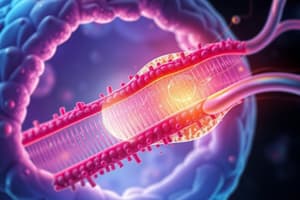Podcast
Questions and Answers
¿Cuál es la principal función de la membrana celular?
¿Cuál es la principal función de la membrana celular?
- Facilita la comunicación entre células adyacentes
- Permite el paso de todo tipo de moléculas a través de ella
- Separa el ambiente intracelular del extracelular (correct)
- Es el principal componente estructural de la célula
¿Qué tipo de moléculas componen principalmente la membrana celular?
¿Qué tipo de moléculas componen principalmente la membrana celular?
- Lípidos y aminoácidos
- Carbohidratos y ácidos nucleicos
- Lípidos y proteínas (correct)
- Proteínas y azúcares
¿Cuál es la función del colesterol en la membrana celular?
¿Cuál es la función del colesterol en la membrana celular?
- Facilita el transporte de moléculas a través de la membrana
- Proporciona energía a la célula
- Participa en la señalización celular
- Ayuda a mantener la estabilidad y fluidez de la membrana (correct)
¿Qué característica de los fosfolípidos les permite formar la bicapa lipídica de la membrana celular?
¿Qué característica de los fosfolípidos les permite formar la bicapa lipídica de la membrana celular?
¿Cuál es la función de las proteínas integrales de la membrana celular?
¿Cuál es la función de las proteínas integrales de la membrana celular?
¿Cuál es la diferencia entre las proteínas extrínsecas e intrínsecas de la membrana celular?
¿Cuál es la diferencia entre las proteínas extrínsecas e intrínsecas de la membrana celular?
¿Cuál es una función clave de las proteínas integrales especializadas en la membrana celular?
¿Cuál es una función clave de las proteínas integrales especializadas en la membrana celular?
¿Qué función desempeñan los receptores y vías de señalización presentes en la membrana celular?
¿Qué función desempeñan los receptores y vías de señalización presentes en la membrana celular?
¿Cómo se ajusta dinámicamente la composición lipídica de la membrana celular durante el crecimiento y división celular?
¿Cómo se ajusta dinámicamente la composición lipídica de la membrana celular durante el crecimiento y división celular?
¿Qué tipo de proteínas se encargan de mediar el transporte selectivo de moléculas a través de la membrana celular?
¿Qué tipo de proteínas se encargan de mediar el transporte selectivo de moléculas a través de la membrana celular?
¿Qué tipo de sistemas se encuentran en las células para detectar y responder a señales internas y externas?
¿Qué tipo de sistemas se encuentran en las células para detectar y responder a señales internas y externas?
¿Por qué es importante que la membrana celular sirva como una barrera?
¿Por qué es importante que la membrana celular sirva como una barrera?
Study Notes
Cell Membrane: Structure and Functions
Introduction
A cell membrane, also known as the plasma membrane, is a lipid bilayer that encircles all living cells. It acts as a selective barrier, maintaining the intracellular environment separate from the extracellular environment. This membrane is composed mainly of lipids and proteins, serving various essential roles in cellular function.
Structure
The cell membrane's primary structure consists of two layers of phospholipids arranged in a lipid bilayer. Phospholipids are amphipathic molecules, meaning they have both hydrophilic (water-attracting) and hydrophobic (water-repelling) regions. The hydrophilic heads face outwards towards the aqueous environment, while the hydrophobic tails are buried within the interior.
Cholesterol is another common component of the cell membrane. It interacts with lipids and helps maintain the membrane's stability and fluidity. Additionally, proteins embedded within the membrane play crucial roles in cellular communication and transportation. These proteins can be extrinsic (loosely attached) or intrinsic (integral) to the membrane.
Functions
Barrier Function
The cell membrane acts as a barrier, preventing large molecules and charged particles (ions) from passing through easily. This property allows cells to maintain distinct chemical compositions within themselves and control interactions with external substances.
Transport Facilitation
To allow selective exchange of molecules, specialized integral proteins exist within the cell membrane. These proteins facilitate diffusion of certain molecules across the lipid bilayer, ensuring the necessary nutrients enter the cell and waste products exit efficiently. Examples include channels, facilitators, and pumps.
Signaling and Communication
Cell membranes contain various receptors, signaling pathways, and transduction systems. These components help cells detect and respond to internal and external signals, ultimately regulating the direction and intensity of biological processes.
Growth and Division
As cells grow and divide, their membranes expand accordingly. The lipid composition and arrangement adjust dynamically, allowing for smooth expansion and contraction during cellular events like cytokinesis.
In conclusion, the cell membrane is a complex system composed of phospholipids, cholesterol, and embedded proteins. It serves multiple critical functions, including serving as a barrier, mediating transport, facilitating communication, and accommodating growth and division.
Studying That Suits You
Use AI to generate personalized quizzes and flashcards to suit your learning preferences.
Description
Descubre todo sobre la membrana celular, una barrera selectiva que rodea las células vivas y desempeña múltiples funciones esenciales en la comunicación y transporte celulares. Aprende sobre su estructura de bicapa lipídica, los componentes como fosfolípidos y proteínas, y sus roles clave en la barrera, el transporte, la señalización y el crecimiento celular.




